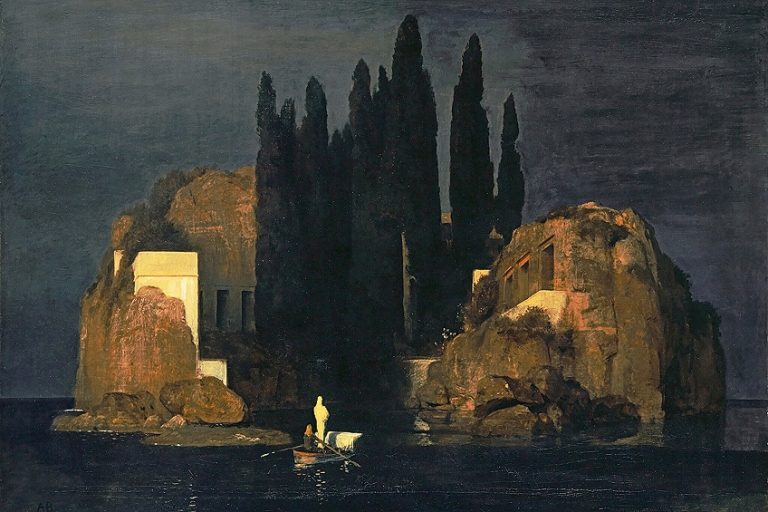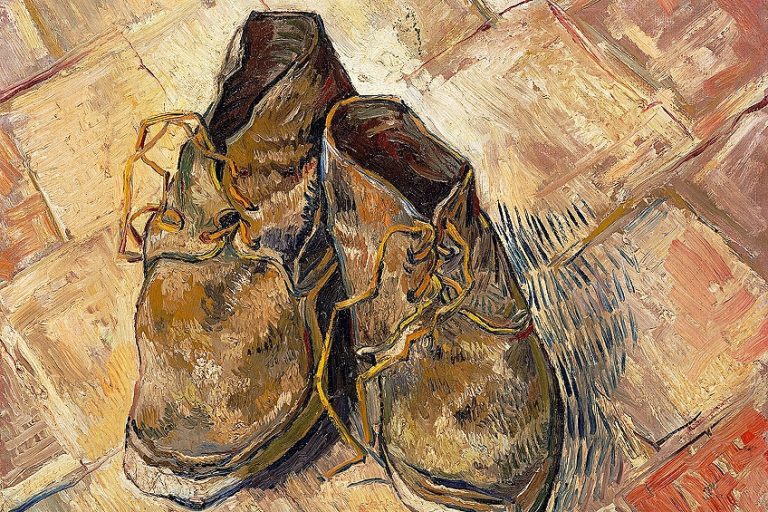“Whaam!” by Roy Lichtenstein – A Pop Art Analysis
Explosions, fighter pilots in the throes of warfare, and rockets blazing through the sky. This is the action that is packed into the two panels in the painting titled Whaam! by Roy Lichtenstein. Read more about this dynamic depiction by one of the most beloved Pop artists below!
Table of Contents
Artist Abstract: Who Was Roy Fox Lichtenstein?
Roy Fox Lichtenstein was born in New York City on October 27, 1923, and died on September 29, 1997, also in New York City. He grew up around music and art from a young age, learning painting and drawing, among other art forms. He also played musical instruments like the clarinet and piano and he loved Jazz; he reportedly had a Jazz band in high school. He also served in the United States Army during World War II. His art style was Pop art, and he became well-known for his reproductions that parodied comic book strips. Some of his popular artworks include Drowning Girl (1963), In the Car (1963), and Girl in Mirror (1964).
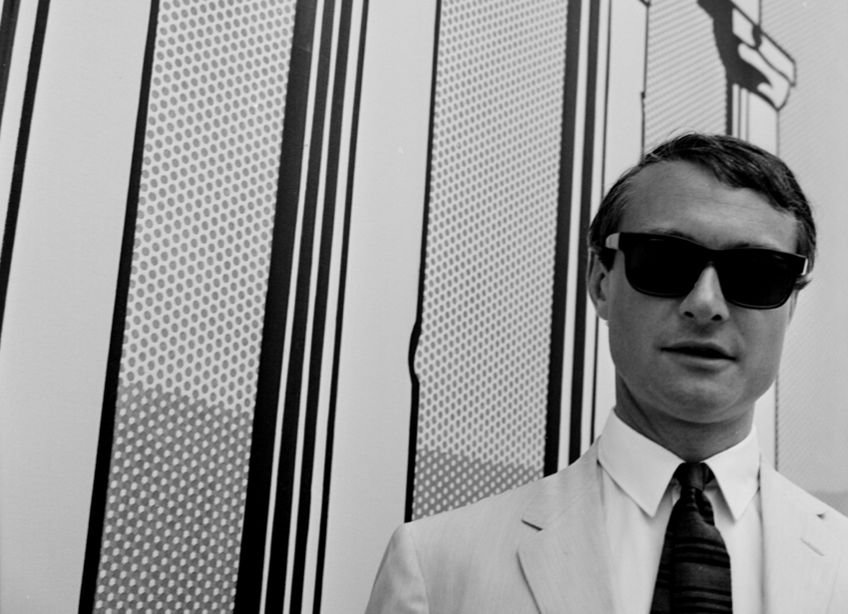
Whaam! (1963) by Roy Lichtenstein in Context
| Artist | Roy Fox Lichtenstein (1923 – 1997) |
| Date Painted | 1963 |
| Medium | Acrylic and oil paint on canvas |
| Genre | Genre painting |
| Period/Movement | Pop art |
| Dimensions (Centimeters) | 172.7 x 406.4 |
| Series/Versions | N/A |
| Where Is It Housed? | Tate Modern, London, United Kingdom |
| What It Is Worth | It was purchased for £3,940 in 1966 from Leo Castelli and Ileana Sonnabend |
In the Whaam! painting analysis you will read more about this diptych, which consists of two canvases. The contextual analysis will introduce the history of the painting with a formal analysis providing a description of the subject matter and how the art elements come together to create a dynamic and action-packed painting.
Contextual Analysis: A Brief Socio-Historical Overview
Whaam! by Roy Lichtenstein was inspired by the DC Comics’ story titled Star Jockey, which was in issue number 89 from the series titled All American Men of War (1962). The image that Lichtenstein reproduced was initially done by the artist Irv Novick. Roy Lichtenstein made several changes to his iteration of the scene compared to the original comic. For example, the type of plane in the original comic was the F-86 Sabre, depicted on the left, and, depicted on the right, the Mikoyan-Gurevich MiG 15. In Lichtenstein’s Whaam! painting, the plane on the left is reportedly a P-51 Mustang, and the plane blowing up on the right is identified as a Sabre plane.
The choice of planes also touches on the inherent symbolism that Lichtenstein conveyed, which you will read more about below.
Other comparisons between Lichtenstein’s Whaam! painting and the original comic includes another dialogue box in the original comic (which is not depicted in Lichtenstein’s Whaam! painting). It comes from the pilot on the left side, who exclaims as he shoots down the pilot on the right, “THE ENEMY HAS BECOME A FLAMING STAR!”. In the original comic, underneath the pilot’s plane on the left side, is another word, “WHOOSH!”, which is not depicted in Roy Lichtenstein’s version. However, the word, “WHAAM!” is in the original comic version, only it is in red, whereas Lichtenstein’s version is in yellow.
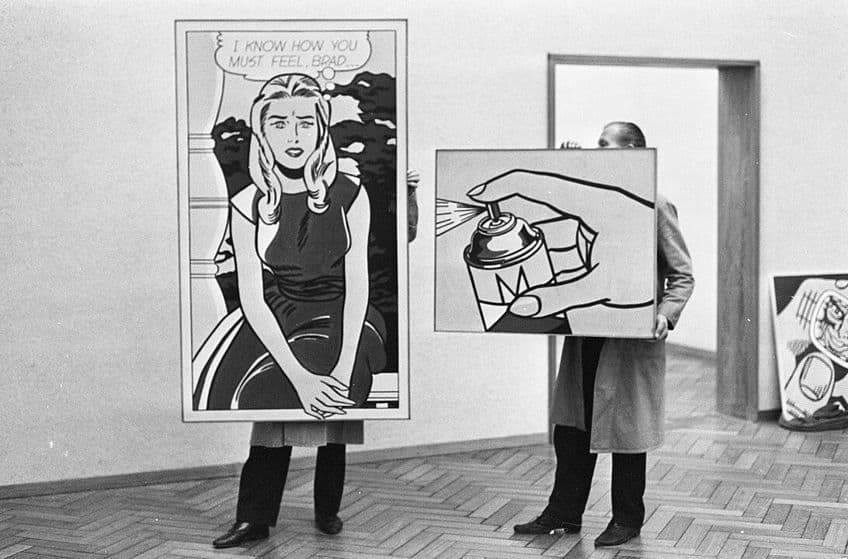
The yellow dialogue box is in the top left corner of the left panel in the original comic, whereas in Lichtenstein’s version, it is in line with the right edge of the left plane’s rudder. Furthermore, the original comic depicts two more planes on the right side, on either side of the blown-up plane, approaching the plane to the left. Lichtenstein’s version does not depict any other planes. The original comic also depicts what appears to be a mountaintop in the lower left corner of the left panel, which is not depicted in Lichtenstein’s version.
An interesting fact about the Whaam! painting is that Lichtenstein reportedly planned to only create one painting, but he decided in the end to produce a diptych, which consists of two panels.
Whaam! Symbolism
The inherent symbolism of Roy Lichtenstein’s Whaam! painting is possibly a play or parody on war, and some sources state, “anti-war”. When Lichtenstein painted Whaam!, it was during the Cold War, which was between the Soviet Union and the United States. It was also a time during the Vietnam War that heightened the sense of war and propagandist devices in culture that perpetuated the ideas of wartime and patriotism, which is also what Lichtenstein’s comic strip could have explored and how war comic books portrayed narratives of war and archetypes that involve heroes and villains.
Roy Lichtenstein’s military service has also been mentioned, he served from 1943 to 1946 in World War II, which undoubtedly could have influenced his approach to his art-making, he also trained as a pilot in the military, but reportedly his training did not continue further, and he was not in active combat.
Additionally, Roy Lichtenstein intended to portray subject matter that he described as “emotionally strong”, which included themes of war, as well as themes around love, the latter can be viewed, for example, from his painting titled Drowning Girl (1963).
Another influence has been proposed as to why Roy Lichtenstein created the Whaam! painting, which could have been an expression of his anger towards his wife Isabel Lichtenstein. Roy and Isabel Lichtenstein divorced in 1965, and the artist dated Letty Eisenhauer. Eisenhauer reportedly stated that Roy Lichtenstein was always angry with Isabel and did not extensively show it, and so his paintings, like Whaam!, were modes to express what has been described as his “revenge fantasies”.

According to the Tate Modern, where the Whaam! painting is held, Roy Lichtenstein created several other paintings inspired by wartime, pilots, and explosions. Examples include Explosion (1965 – 1966), which is a lithograph on paper, and Wall Explosion II (1965), which is enamel on steel. These (described as “stylized”) depict variations of what an explosion would appear like but in a comical portrayal.
Other paintings depict Lichtenstein’s utilization of onomatopoeia, which are words that sound like real-life sounds, like the word “Whaam!”.
Additionally, these paintings also include Lichtenstein’s theme of explosions and fighter pilots. These include Brattata (1962), Blam! (1962), Varoom! (1963), Okay Hot-Shot, Okay! (1963), Bratatat! (1963), and his triptych As I Opened Fire (1964).
Sketching Whaam!
Roy Lichtenstein also produced preparatory drawings before he created his Whaam! painting, which is titled Drawing for Whaam! (1963) and is also held in the Tate Modern in London. It is created with a graphite pencil on paper. This drawing was reportedly Lichtenstein’s initial sketch for the Whaam! painting.
Notable differences are evident between the drawing and the final painting, for example, the drawing intended for the word, “Whaam!”, to be white, but Lichtenstein opted for yellow in the end.
Formal Analysis: A Brief Compositional Overview
The formal analysis will discuss Roy Lichtenstein’s Whaam! painting in more detail, what the subject matter consists of, and how the main elements of art – these consist of color, value, texture, line, shape, form, and space – are utilized and occur throughout the composition.

Subject Matter: Visual Description
Whaam! by Roy Lichtenstein consists of two canvases, which is known as a diptych. Coming in strong from the left side of the left canvas is a silver fighter plane. The flyer in the cockpit is identified by a white helmet. There are black and white markings on the plane, notably a white star on its right side (facing us, the viewers) and black and white bands on its rudder.
A yellow phrase box is depicted alongside the plane’s rudder, in it are the words written in black capital letters.
These possibly suggest what the pilot might be saying, “I PRESSED THE FIRE CONTROL…AND AHEAD OF ME ROCKETS BLAZED THROUGH THE SKY…” A white strip of smoke is visible underneath the plane along with long yellow and red lines leading from the lower left corner of the left canvas and all the way into the right canvas where it has already met with another fighter plane in the right panel.

This line suggests the movement of a rocket that just blasted into the plane to the right, which is already in the process of blowing up and engulfed in large white, red, and yellow flames. The word “WHAAM!” in yellow and capital letters is visible in the left quadrant of the right panel, which describes the action taking place. This is also called an onomatopoeic device, which are words that describe a sound being made, and here it is the explosion.
Color and Value
The colors in Whaam! by Roy Lichtenstein are minimal and consist of the primary yellow, red, and blue, namely the yellow and reds suggest the fire, and the blue is a light value that depicts the sky as the background. The phrase box and “WHAAM!” are in yellow. Neutral colors, white, black, and gray are utilized on the planes and smoke, including the bold and thick lines.
The shadow on the plane’s side is purple.

Texture
Roy Lichtenstein was known for his utilization of Ben-Day dots, which created a textured effect in his compositions. In the Whaam! painting these are visible in the background that composes the sky and the side of the plane.

Line
Lines are an important aspect of the Whaam! painting and there are a variety of them, all ranging from different widths, lengths, and shapes. There are also thick black outlines, all of which create contrast and dynamism in the composition. Furthermore, the lines are directional and convey motion. For example, the long straight line underneath the plane indicates the rocket shot towards the other plane.
Notice also the straight and curved emanating lines to imply and emphasize the blast of the plane in the right panel.

Space
Roy Lichtenstein creates a close-up view and perspective of the action taking place in the Whaam! painting. There are no other objects visible but the incoming fighter plane to the left that just blasted the plane to the right. It is as if we, the viewers, have a front-row seat on the action taking place.

Shape and Form
There are a variety of shapes that compose Whaam! by Roy Lichtenstein. These are all irregularly shaped with more two-dimensionality due to minimal shading and depth created. This provides a flat appearance but still retains the dynamism of the composition.
Some of the shapes include the star shape on the plane’s side but also notice the star-like shape created from the flames on the right side. The different types of lines also create shapes.
For example, the black and white bands of lines create rectangular shapes on the plane and the cross-hatched type lines on the plane’s right wing appear as small squares. The more geometric shape of the plane slightly contrasts with the more organic and curved forms of the smoke under the plane.
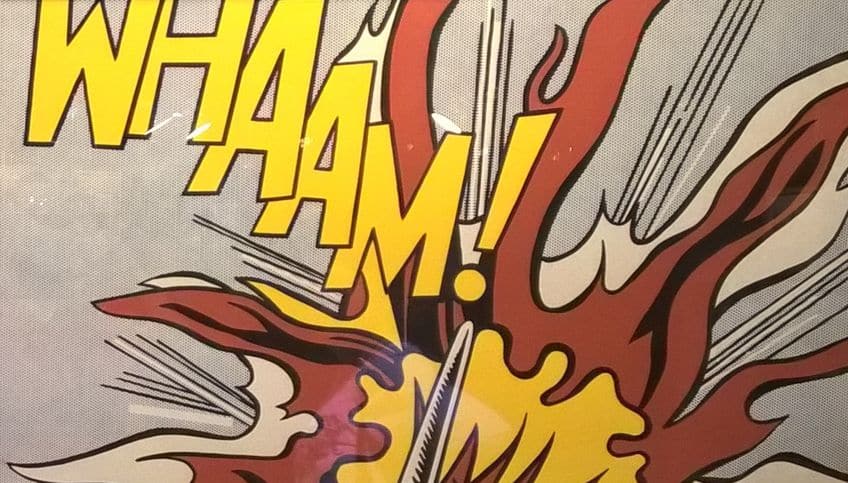
Going Out With a Bang
Roy Lichtenstein’s Whaam! painting has been lauded as one of his most famous artworks, which continued to influence and inspire other artists and make its mark on the art world and popular culture. Whaam! was exhibited in 1963 at the Leo Castelli Gallery located in New York City and it was purchased by the Tate Modern in London England in 1966 for £3,940, reportedly after some deliberation by several of the trustees who questioned the painting’s eligibility for the museum, but it eventually found its way into the museum and continued to make grand impression on its viewers.
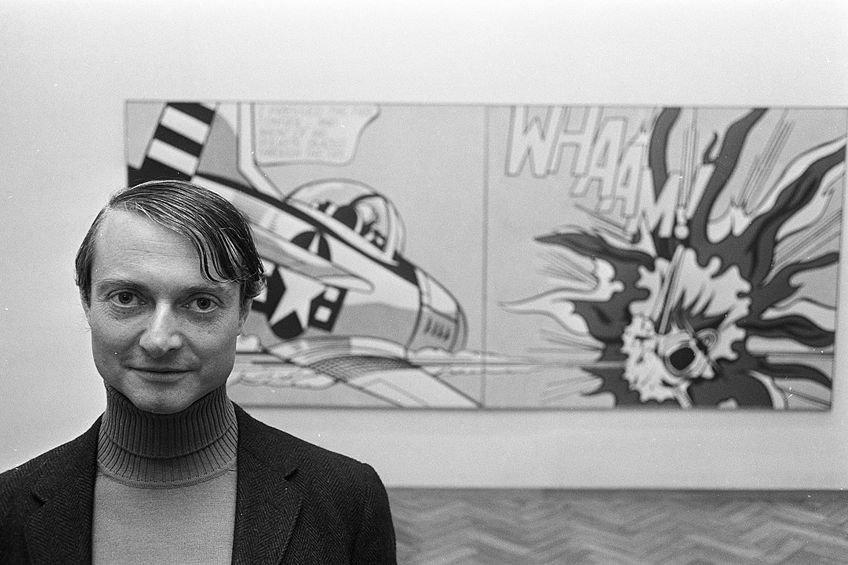
Roy Lichtenstein was an iconic Pop artist and has been both criticized and applauded for his unique artistic style. Some believe he copied other artworks, but he ultimately created from his own perspectives as a Pop artist.
Frequently Asked Questions
Who Painted Whaam!?
The famous Pop artist, Roy Lichtenstein, painted Whaam! (1963). It is an acrylic and oil painting on canvas, which depicts a fighter pilot blowing up another fighter pilot ahead of him. It is depicted in the moment of dynamic action and resembles a comic book strip in style.
What Is the Whaam! Painting Based On?
Roy Lichtenstein based his Whaam! painting on the DC Comics’ issue number 89 of the All American Men of War (1962) series. It was about the part from the story titled Star Jockey by Irv Novick, who created the artwork.
Where Is Whaam! by Roy Lichtenstein?
The famous Whaam! painting that the Pop artist Roy Lichtenstein, painted is at the Tate Modern in London, the United Kingdom. It was purchased in 1966 for £3,940 from Leo Castelli and Ileana Sonnabend. The latter was an art dealer and owned The Sonnabend Gallery in Paris.
Alicia du Plessis is a multidisciplinary writer. She completed her Bachelor of Arts degree, majoring in Art History and Classical Civilization, as well as two Honors, namely, in Art History and Education and Development, at the University of KwaZulu-Natal, South Africa. For her main Honors project in Art History, she explored perceptions of the San Bushmen’s identity and the concept of the “Other”. She has also looked at the use of photography in art and how it has been used to portray people’s lives.
Alicia’s other areas of interest in Art History include the process of writing about Art History and how to analyze paintings. Some of her favorite art movements include Impressionism and German Expressionism. She is yet to complete her Masters in Art History (she would like to do this abroad in Europe) having given it some time to first develop more professional experience with the interest to one day lecture it too.
Alicia has been working for artincontext.com since 2021 as an author and art history expert. She has specialized in painting analysis and is covering most of our painting analysis.
Learn more about Alicia du Plessis and the Art in Context Team.
Cite this Article
Alicia, du Plessis, ““Whaam!” by Roy Lichtenstein – A Pop Art Analysis.” Art in Context. October 25, 2023. URL: https://artincontext.org/whaam-by-roy-lichtenstein/
du Plessis, A. (2023, 25 October). “Whaam!” by Roy Lichtenstein – A Pop Art Analysis. Art in Context. https://artincontext.org/whaam-by-roy-lichtenstein/
du Plessis, Alicia. ““Whaam!” by Roy Lichtenstein – A Pop Art Analysis.” Art in Context, October 25, 2023. https://artincontext.org/whaam-by-roy-lichtenstein/.




